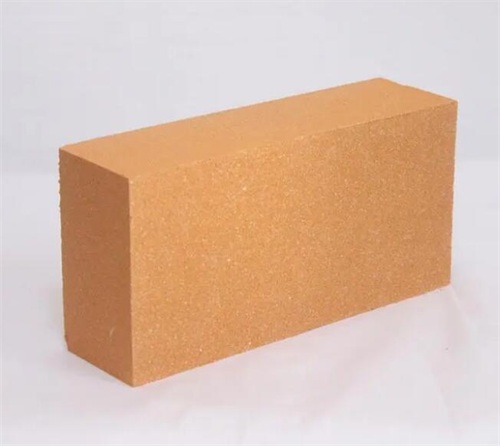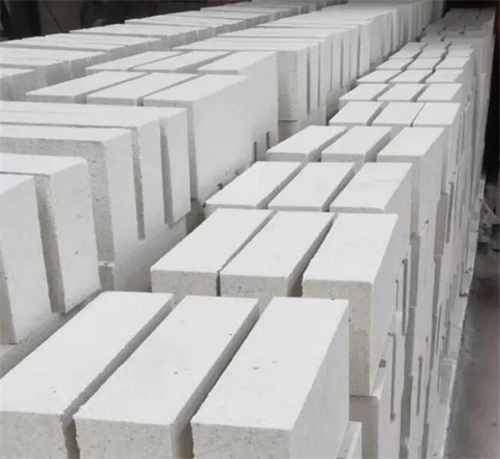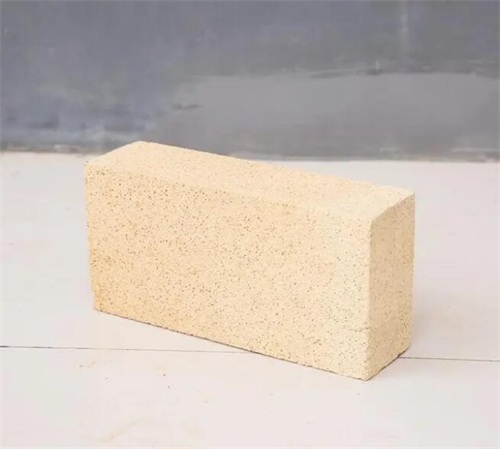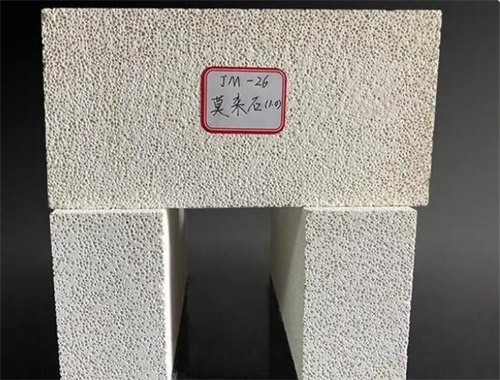The raw materials used for lightweight refractory bricks can be divided into clay, silicon, aluminum and mullite. The reason why lightweight bricks can be insulated is because the bricks contain a small amount of pores (including open pores and open pores). The methods of forming pores include adding combustibles, foam, and chemical methods. Lightweight refractory bricks have low compressive strength, poor slag resistance, poor thermal shock resistance, and cannot be in direct contact with glass liquid or flames.
1. Lightweight clay insulation brick
Clay insulation brick is a thermal insulation refractory product made of refractory clay as the main raw material with an AL2O3 content of 30%-48%. Its production process adopts burn-out addition method and foam method. Using refractory clay, floating beads and refractory clay clinker as raw materials, adding binder and sawdust, after batching, mixing, molding, drying and firing, the product with a bulk density of 0.3-1.5g/cm3 is obtained. The output of clay-based insulating bricks accounts for more than half of the total output of insulating refractory bricks. The Chinese standard (GB3994-1983) divides clay insulation bricks into NG-1.5, NG-1.3a, NG-1.3b, NG-1.0, NG-0.9, NG-0.8, NG-0.7, NG- 0.6, NG-0.5, NG-0.4, 10 grades.
It has a wide range of applications, and is mostly used in thermal insulation layers of thermal equipment and industrial furnaces.
2. Lightweight silica brick
Lightweight silica bricks are also called silica heat insulation bricks. A lightweight refractory material with a silica content of more than 91% and a bulk density of less than 1.2g/cm3. The refractoriness and load softening temperature are not much different from ordinary silica bricks with the same composition. However, due to the large number of pores, the compressive strength, slag resistance, and corrosion resistance are not as good as ordinary silica bricks, but the thermal shock resistance has been improved.
Finely crushed silica is used as raw material, and its critical particle size is usually not more than 1mm, and the particles smaller than 0.5mm are not less than 90%. Add flammable substances to the ingredients or use the gas generation method to form a porous structure, and then it is made by firing. It can also be made into non-fired products. It is mainly used in various parts of the kiln that require heat insulation or light weight without direct contact with the molten material, without the action of corrosive gases, and without being subjected to sudden temperature changes. It is used at high temperature and cannot be in contact with alkaline refractory materials. According to different materials, its service temperature is 1200~1550℃.
Lightweight silica brick is a very special material, mainly used in glass industry and steel industry. In most cases, lightweight silica bricks and dense silica bricks are used as part of the structural layer. It is commonly used in the glass kiln industry, mainly for the insulation of the kiln vault, thereby reducing heat loss and increasing the efficiency of the melting process. In the steelmaking industry, lightweight silica bricks are used for the light weight of walls and domes of hot blast furnaces.

1. Lightweight silica bricks are used in the glass industry - heat insulation of furnace vaults
During the glass melting process, very high temperatures are reached in the convex lower part of the vault. Depending on the type of glass, the temperature is around 1600°C. Lightweight layers are usually designed in two or more layers.
Lightweight silica bricks are primarily exposed to these temperature loads. The same or similar expansion properties are expected for the single layers of the vault (structural and lightweight layers). Silica bricks with a bulk density of 1250kg·m-3 or 1000kg·m-3 can meet the requirements of the dense layer. The next layer uses silica bricks with a bulk density of 800Kg·m-3 or 600kg·m-3.
Lightweight silica bricks can be freely coded on the furnace arch, or bonded with silica fire clay. There is no chemical load during the furnace service period (several years). Lightweight silica bricks are mainly used because the chemical and mineral composition is similar to dense silica bricks used for working linings.

2. Lightweight silica bricks are used in the steel industry - hot blast furnace
The hot blast stove is often used for hot air (called blast furnace blast), which is connected with the air extractor of the blast furnace. According to the shape and location of the hot blast stove, the temperature range is between 1000 ~ 1300 ° C, and the hot air is 2300 ~ 6500m3 min- 1 range.
This necessitated the calculation of a comparison between hot blast stoves (with different component sizes and usage locations) and glass furnace vaults at different levels and various loads, focusing on thermomechanical properties. For lightweight layers, the bulk density used is 1250kg·m-3 or 1050kg·m-3 (mainly due to their higher strength).

3. High alumina poly light brick
High-alumina poly-light insulation bricks, also known as high-alumina poly-light ball bricks, are produced with super-grade blast furnace materials as the main raw material, supplemented with appropriate admixtures, and produced by poly-light burning loss method. The product has the advantages of high strength, good thermal stability, small change of reburned fiber, and small thermal conductivity.
High-alumina poly-light insulation bricks are usually made of high-alumina bauxite clinker and a small amount of clay. After grinding, they are cast in the form of slurry by gas generation method or foam method, and fired at 1300-1500 °C. Sometimes industrial alumina can also be used to replace part of the alumina clinker. It is used for the inner lining and heat insulation layer of masonry kilns, and the parts without strong erosion and erosion of high-temperature molten materials. When in direct contact with the flame, the surface contact temperature shall not be higher than 1350°C.
Product features: 1. High strength at high temperature; 2. Good thermal insulation performance; 3. Corrosion resistance in various atmospheres; 4. Significant energy-saving effect; 5. Excellent thermal shock stability.
Product Usage:
High-aluminum poly-light bricks have reached various technical indicators of similar products in the world, and are the new materials that must be selected in the design of industrial kilns. It is widely used in kiln lining (not eroded by solution) and insulation layer in metallurgy, machinery, ceramics and chemical industries. It is an ideal energy-saving product. Its use temperature is below 1350°C.

4. Mullite insulation brick
Lightweight mullite insulation brick is a thermal insulation refractory product made of mullite as the main raw material. Mullite insulation bricks are resistant to high temperature, high in strength, low in thermal conductivity, and can be directly exposed to flames. They are suitable for the lining of various industrial kilns.
Mullite insulation bricks are also classified according to different densities. They are divided into light mullite insulation bricks and heavy mullite insulation bricks. According to different use temperatures, they are divided into 1350 mullite insulation bricks and 1450 Stone insulation bricks, 1550 mullite insulation bricks, 1550 mullite insulation bricks, etc. are generally used as bricks such as fire pits because of their high heat resistance.
Mullite insulation bricks have high performance and high refractoriness, and can withstand high temperatures of 1800 ° C. However, mullite insulation bricks will begin to soften at 1600 to 1700 ° C and will not burn. However, its normal temperature compressive strength is also high, ranging from 70 to 260MPa, and it has good thermal shock resistance. Mullite insulation brick is a new type of refractory material in my country, which can directly contact the flame, has the characteristics of high temperature resistance, high lightness, small thermal conductivity, and remarkable energy-saving effect.
Mullite insulation bricks are suitable for lining of cracking furnaces, hot blast furnaces, ceramic roller kilns, electric porcelain drawer kilns, glass crucibles and various electric furnaces. It is used for the roof of hot blast stove, furnace body and bottom of blast furnace, regenerator of glass melting furnace, ceramic sintering kiln, furnace lining of petroleum cracking system, etc. Mullite insulation bricks also have the characteristics of high load softening temperature, compact structure, low porosity, and good erosion resistance.
Contact: Mgr. Han
Phone: 0086-13589497465
Email: 1255953279@qq.com
Add: Industrial Area of Lingzi Town,Zichuan District,Zibo City, Shandong,China